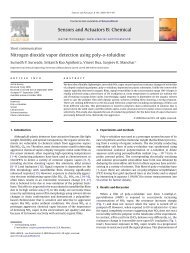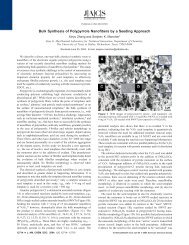Nanofibers of polyaniline synthesized by ... - Sanjeev Manohar
Nanofibers of polyaniline synthesized by ... - Sanjeev Manohar
Nanofibers of polyaniline synthesized by ... - Sanjeev Manohar
You also want an ePaper? Increase the reach of your titles
YUMPU automatically turns print PDFs into web optimized ePapers that Google loves.
28 X. Zhang et al. / Synthetic Metals 145 (2004) 23–29<br />
Fig. 3. Cyclic voltammograms <strong>of</strong> <strong>polyaniline</strong>·CSA powder in aq. 1.0 M CSA electrolyte (SCE reference): (A) fibrillar morphology, average fiber diameter<br />
28 nm; (B) non-fibrillar morphology.<br />
phase segregation <strong>of</strong> the “bulk” emeraldine oxidation state<br />
into extended runs <strong>of</strong> fully reduced leucoemeraldine segments<br />
and fully oxidized pernigraniline segments [28].<br />
Since only the “true” emeraldine segments can be doped,<br />
the total doping percentage is expected to be lower than<br />
50%. Phase segregation <strong>of</strong> the emeraldine oxidation state<br />
has been previously observed in <strong>polyaniline</strong> films that<br />
display inconsistent electroluminescent behavior [28].<br />
Aqueous electrochemistry is an important and sensitive<br />
tool to characterize doped <strong>polyaniline</strong> powder, e.g., cyclic<br />
voltammograms obtained in aq. 1.0 M acids have helped<br />
determine its purity and identify structural defects along<br />
the polymer backbone [19]. The cyclic voltammograms <strong>of</strong><br />
<strong>polyaniline</strong> nan<strong>of</strong>ibers <strong>synthesized</strong> in this study show two<br />
redox peaks characteristic <strong>of</strong> the parent <strong>polyaniline</strong> system<br />
whose E 1/2 values are essentially identical conventional<br />
(non-fibrillar) emeraldine·CSA (Fig. 3). This suggests that<br />
not only are the nan<strong>of</strong>ibers free <strong>of</strong> any backbone-related defects<br />
but that the aqueous electrochemistry <strong>of</strong> <strong>polyaniline</strong>,<br />
at least in these instances, is not significantly affected <strong>by</strong><br />
polymer morphology.<br />
Previous studies on the electronic conductivity <strong>of</strong> <strong>polyaniline</strong><br />
nan<strong>of</strong>ibers obtained <strong>by</strong> the “non-template” method<br />
indicate that inter-fiber resistance can play a major role in<br />
reducing the conductivity to values as low as ∼10 −2 S/cm<br />
[25]. In our studies, the 4-probe pressed-pellet room temperature<br />
DC conductivity was consistently in the range<br />
1–5 S/cm regardless <strong>of</strong> doping percentage and/or fiber morphology.<br />
It is possible, however, that the high pressures used<br />
to prepare pellets for conductivity measurements might have<br />
destroyed the fibrillar morphology precluding any interfiber<br />
charge transport effects.<br />
Polyaniline nan<strong>of</strong>ibers are expected to have large accessible<br />
surface areas which could be potentially leveraged to<br />
advantage in capacitive charge storage applications [29].<br />
The capacitance <strong>of</strong> <strong>polyaniline</strong> nan<strong>of</strong>ibers increases as<br />
the fiber diameter decreases. Summarized in Table 1, a<br />
value <strong>of</strong> 277 F/g was observed for <strong>polyaniline</strong>·AMPSA (no<br />
Fig. 4. Cumulative charge/discharge capacity <strong>of</strong> <strong>polyaniline</strong>·AMPSA (over 50 cycles) in the range 0.4–0.5 V (vs. SCE) in aq. 1.0 M CSA electrolyte:<br />
(A) fibrillar morphology, average fiber diameter 23 nm [(0.1156 mAh × 3.6)/(50 cycles × 0.1V× 0.3mg) = 277 F/g)]; (B) non-fibrillar morphology<br />
[(0.0093 mAh × 3.6)/(50 cycles × 0.1V× 0.6mg) = 11 F/g)].




